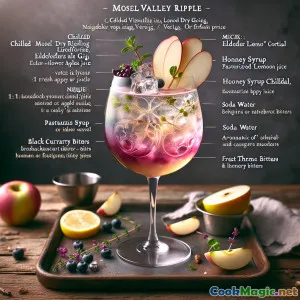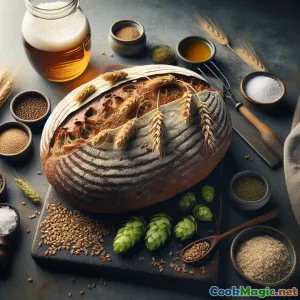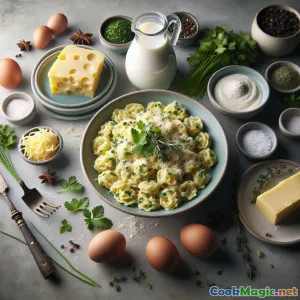
Wellen des Mosel-Tals: Holunderblüten-Riesling-Cocktail
(Mosel Valley Ripple: Elderflower Riesling Cocktail)
(0 Bewertungen)0
361
November 07, 2025
Problem melden
Zutaten
-
150 ml Mosel Trocken Riesling (gekühlt)
(Choose a crisp Kabinett trocken or dry Riesling)
-
40 ml London Dry Gin
(For a lighter drink, reduce to 20 ml per drink or omit)
-
20 ml Holunderblütenlikör (oder Sirup)
(Adjust to taste for sweetness; cordial is non-alcoholic)
-
60 ml Trüber Apfelsaft
(Unsweetened preferred, from tart apples)
-
10 ml Verjus oder frischer Zitronensaft
(Adds gentle acidity without overpowering the Riesling)
-
10 ml Honig-Sirup (1:1, Honig:Wasser)
(Warm gently to dissolve if making fresh)
-
30 ml Pasteurisiertes Eiweiß
(For foam; substitute aquafaba 30 ml for vegan option)
-
90 ml Kohlensäurehaltiges Wasser, gekühlt
(Adds lift and a delicate spritz)
-
10 ml Schwarzer Johannisbeersirup (Cassis)
(Drizzle to create the signature ripple)
-
2 dashes Aromatische oder Heidelbeer-Bitters
(Accentuates fruit; omit if using cordial)
-
2 cups Eiswürfel
(Use clear, fresh ice for the cleanest flavor)
-
2 pieces Dünne Apfelscheiben
(Optionale Garnitur)
-
2 sprigs Frische Thymianzweige
(Optional aromatic garnish)
(Choose a crisp Kabinett trocken or dry Riesling)
(For a lighter drink, reduce to 20 ml per drink or omit)
(Adjust to taste for sweetness; cordial is non-alcoholic)
(Unsweetened preferred, from tart apples)
(Adds gentle acidity without overpowering the Riesling)
(Warm gently to dissolve if making fresh)
(For foam; substitute aquafaba 30 ml for vegan option)
(Adds lift and a delicate spritz)
(Drizzle to create the signature ripple)
(Accentuates fruit; omit if using cordial)
(Use clear, fresh ice for the cleanest flavor)
(Optionale Garnitur)
(Optional aromatic garnish)
Nährwerte
- Portionen: 2
- Portionsgröße: 1 coupe (180 ml)
- Calories: 210 kcal
- Carbohydrates: 0 g
- Protein: 2 g
- Fat: 0 g
- Fiber: 0 g
- Sugar: 16 g
- Sodium: 25 mg
- Cholesterol: 0 mg
- Calcium: 15 mg
- Iron: 0.3 mg
Anweisungen
-
1 - Chill and prep:
Chill two coupe glasses and all liquid ingredients. Assemble tools: shaker, strainer, fine strainer, jigger, barspoon, and pick or skewer for rippling.
-
2 - Build the shake:
In a shaker, add gin, elderflower liqueur, apple juice, verjus, honey syrup, and egg white (or aquafaba). Do not add Riesling or soda yet.
-
3 - Dry Shake for Foam:
Seal and shake without ice for 15–20 seconds to aerate, creating a smooth, stable foam.
-
4 - Wet shake to chill:
Add plenty of ice and shake vigorously for another 15–20 seconds until the shaker is frosty.
-
5 - Strain and layer:
Double strain into the chilled coupes. Gently float the chilled Riesling over the back of a spoon, then top with soda to lift the foam.
-
6 - Create the ripple:
Drizzle blackcurrant syrup in a thin spiral over the foam. Optionally add bitters. Drag a cocktail pick through the surface to create gentle river-like ripples.
-
7 - Garnish and Serve:
Perch a thin apple slice on the rim and add a small thyme sprig. Serve immediately while effervescent.
Chill two coupe glasses and all liquid ingredients. Assemble tools: shaker, strainer, fine strainer, jigger, barspoon, and pick or skewer for rippling.
In a shaker, add gin, elderflower liqueur, apple juice, verjus, honey syrup, and egg white (or aquafaba). Do not add Riesling or soda yet.
Seal and shake without ice for 15–20 seconds to aerate, creating a smooth, stable foam.
Add plenty of ice and shake vigorously for another 15–20 seconds until the shaker is frosty.
Double strain into the chilled coupes. Gently float the chilled Riesling over the back of a spoon, then top with soda to lift the foam.
Drizzle blackcurrant syrup in a thin spiral over the foam. Optionally add bitters. Drag a cocktail pick through the surface to create gentle river-like ripples.
Perch a thin apple slice on the rim and add a small thyme sprig. Serve immediately while effervescent.
Mehr über: Wellen des Mosel-Tals: Holunderblüten-Riesling-Cocktail
Story and Inspiration
The Mosel Valley Ripple pays homage to Germany’s Mosel River, whose winding bends are mirrored in the cocktail’s delicate blackcurrant swirls. The Mosel is synonymous with Riesling—slender slopes planted with vines that capture ripeness and nerve in equal measure. This drink aims to showcase that signature balance: bright orchard fruit, honeysuckle florals, and a clean mineral line that makes Mosel wines so refreshingly drinkable. By keeping the spirit base gentle and highlighting wine, we let the Riesling sing while framing it with light botanical and fruit notes.
Flavor Profile
Imagine the first pour of a dry Mosel Riesling—green apple, white peach, and lime zest—now lifted with elderflower’s perfume and rounded by a whisper of honey. Cloudy apple juice stitches the fruit together while verjus (or lemon) sharpens the edges. A kiss of soda amplifies the wine’s natural sparkle. The silky foam crowns the glass, providing a canvas for a blackcurrant ripple that drifts like the river itself and adds a tart, ruby streak to each sip.
Technique Tips
- Foam choices: Pasteurized egg white delivers the silkiest head and classic cocktail texture. For a vegan option, aquafaba (chickpea water) offers excellent foam with a slightly lighter mouthfeel. Either way, dry shake first to aerate; then wet shake with ice to chill and refine the foam.
- Layering the wine: Add the Riesling after straining the shaken base. Pouring over the back of a barspoon helps it float gently and avoids collapsing the foam. Finish with soda to lift and lace bubbles through the drink.
- The ripple: Use a fine-spouted bottle for the blackcurrant syrup. Start in the center, spiral outward, then drag a pick through the surface in alternating directions. You only need a little—too much syrup will oversweeten and obscure the Riesling.
- Temperature matters: Keep the Riesling and soda very cold. Warmer wine will taste flatter and may disrupt the airy crown.
Ingredient Notes and Substitutions
- Riesling: Look for a dry Mosel Riesling (Kabinett trocken or Trocken). Off-dry styles can work; simply reduce or omit the honey syrup. A Mosel Sekt (sparkling Riesling) makes a more celebratory take—use less soda and skip bitters.
- Gin: A clean London dry style keeps botanicals neat and crisp. For a low-ABV version, halve or omit the gin and increase Riesling by 20–30 ml total, tasting as you go.
- Elderflower: Liqueur brings sweetness and alcohol; cordial is non-alcoholic and sweeter. Adjust honey accordingly.
- Citrus vs. verjus: Verjus offers gentle acidity and rounds the edges; lemon gives a brighter, zippier snap. Either is excellent—choose based on your Riesling’s sweetness.
- Syrup: Honey’s floral tone threads naturally into Riesling’s aromatics. A 1:1 honey syrup blends more easily than straight honey.
Serving and Pairing
Serve in chilled coupes to elevate the aromatics and showcase the foam artwork. This cocktail excels as a brunch centerpiece or aperitif. Pair with soft cheeses (young goat or a mild bloomy rind), smoked trout on rye, or apple-and-fennel salads. Lightly sweet pastries—almond tarts or lemon poppy seed cake—also echo the drink’s citrus-floral lift.
Make-Ahead and Batch Tips
- Pre-batch the shaken base (without egg white) up to 24 hours ahead and keep chilled. Add egg white or aquafaba per order, shake, then layer Riesling and soda.
- Chill your coupes in the freezer for 10–15 minutes; glass temperature is a silent ingredient.
Safety and Quality
Use pasteurized egg whites if choosing the classic foam. If you prefer to avoid egg products, aquafaba is a reliable stand-in with excellent stability. Always taste your Riesling first—if it’s slightly off-dry, dial back honey. If it’s very lean and steely, you can bump honey by a few milliliters.
Variations
- Slate and Citrus: Replace blackcurrant syrup with a thin strip of lemon zest expressed over the foam and discard; dot with orange bitters.
- Garden Ripple: Swap thyme for a small rosemary sprig and infuse your honey syrup with the herb for 10 minutes while warming.
- Rosé Mosel: If you find a Mosel rosé, use it for a pink-tinted riff; keep the cassis minimal to avoid overpowering the wine.
Why It’s Unique
Most wine cocktails either drown the wine in stronger spirits or sweeten it beyond recognition. Mosel Valley Ripple does the opposite: it centers the Riesling and uses spirits and syrups as gentle brushstrokes. The visual ripple is more than garnish—it’s a thematic nod to the Mosel’s serpentine path and a measured flavor accent that keeps the palate curious from first sip to last.
Enjoy this elegant, effervescent tribute to one of the world’s great white-wine regions—light enough for afternoon sunlight, nuanced enough for contemplative evenings.























